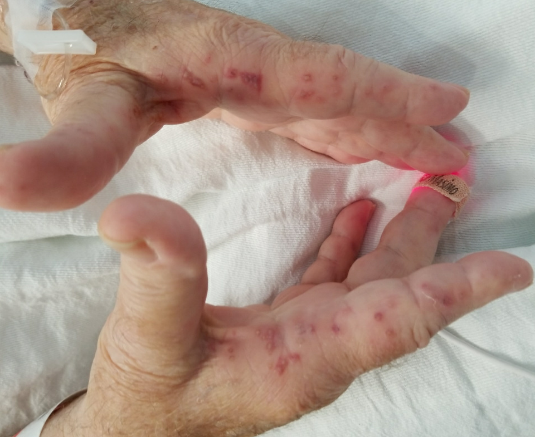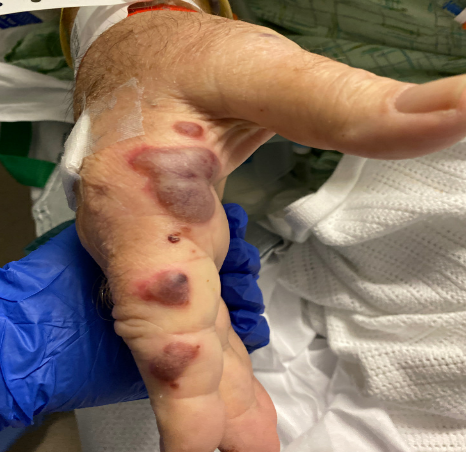Case Presentation: A 74 year-old man with coronary artery disease and hypertension, who was two weeks post-admission for cholangitis with biliary-tube placement and ATN, re-presented to our institution with weakness, subacute progressive abdominal distension, and diffuse abdominal pain in the setting of serosanguineous biliary tube output. He was febrile with a leukocytosis and started on vancomycin and piperacillin-tazobactam. No clear infectious source or organism was identified despite extensive workup. Antibiotics were discontinued after 48 hours. He was anemic, requiring 2U pRBCs and subsequently developed hypoxia secondary to transfusion-associated circulatory overload, requiring ICU care for respiratory support and diuresis. His course was complicated by scattered joint stiffness with elevated ESR/CRP and an acute eruption of hemorrhagic blisters on bilateral hands (Fig.1). Skin biopsy revealed neutrophilic dermatosis with massive dermal edema, consistent with Sweet Syndrome (SS). He improved clinically and was discharged home on hospital day 8.One day following discharge, he re-presented with rigors, fever, hypoxia and hypotension, concerning for septic shock. He was started on vancomycin, cefepime and metronidazole. His hospital course was further complicated by transfusion-dependent anemia, hypoxic respiratory failure, AKI, new-onset anxiety, and persistent bilateral hand lesions (Fig. 2). He underwent extensive workup, with imaging revealing bilateral pleural and pericardial effusions, though cultures and imaging again revealed no source of infection. Disseminated sweet syndrome (dSS) was felt to be a unifying diagnosis, and antibiotics were discontinued in favor of methylprednisolone, which rapidly improved his systemic symptoms. A bone marrow biopsy revealed MDS vs. developing AML, thought to be the underlying driver of his dSS. He chose to pursue hospice care and died 4 days after discharge.
Discussion: Sweet syndrome, or acute febrile neutrophilic dermatosis, is a rare inflammatory condition with pathogenesis thought to be related to maladaptive elevations in G-CSF. SS is characterized by abrupt development of fever, neutrophilia and painful erythematous papules/ nodules, commonly found on the dorsal upper extremities. SS is often associated with underlying- or post- infectious states, pregnancy, IBD, drug reactions or malignancy. Extracutaneous manifestations may occur, including pleural and pericardial effusions; renal, hepatic and pancreatic insufficiencies; and neuropsychiatric changes. Rarely SS can present as disseminated Sweet Syndrome with multisystem inflammatory involvement and hemodynamic instability mimicking septic shock, although there will be no underlying infectious cause or improvement with antibiotics. Treatment of dSS with systemic steroids typically leads to clinical improvement.
Conclusions: dSS should be considered in patients who have acute onset of fever with painful erythematous papules/nodules, anemia, effusions and symptoms consistent with sepsis without a clear infectious source. Prompt exclusion of infectious causes is paramount to management with initiation of steroids, as delays in steroid administration can lead to significant morbidity. Importantly, SS is often associated with an underlying inflammatory condition or malignancy, with hematologic malignancies as common drivers, so further evaluation for these should be pursued. Treatment of the underlying malignancy is definitive therapy for SS.


